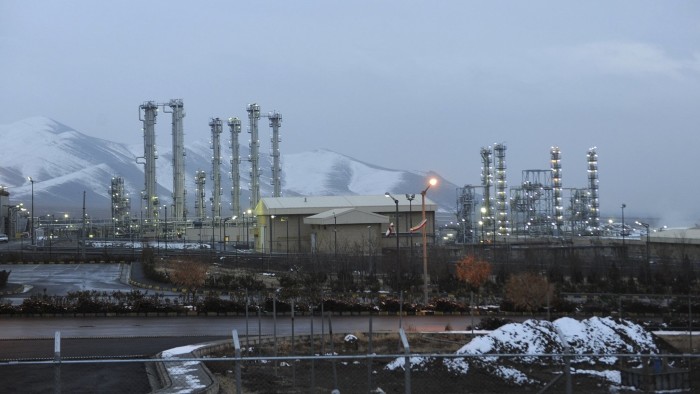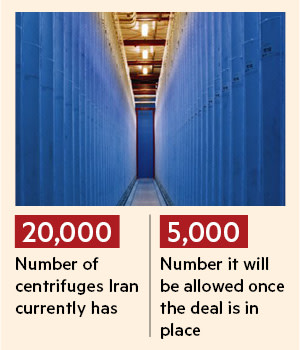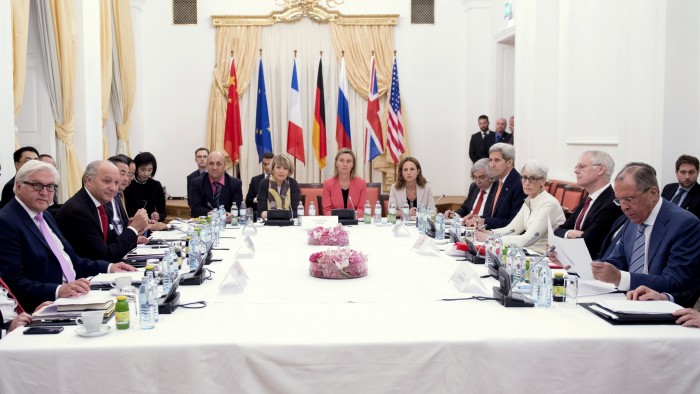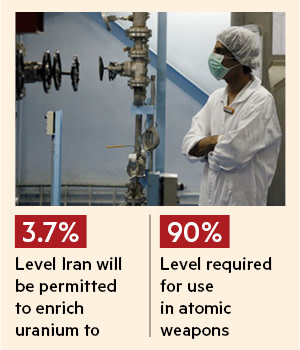Five key points of the Iran nuclear deal explained

Roula Khalaf, Editor of the FT, selects her favourite stories in this weekly newsletter.
Whether it lasts and how history will regard it remain to be seen, but the nuclear agreement signed on Tuesday in Vienna by six world powers and Iran promises to have a sweeping impact on both the citizens of the Islamic Republic and potentially the geopolitics of the entire Middle East.
Nearly two years of lengthy, dense and highly technical discussions have resulted in a 159-page treaty with five annexes that is fittingly arcane and complex. The agreement boils down to five key areas.
Sanctions relief
Tehran wanted immediate removal of the economic and financial curbs that have throttled its economy. Under the deal, all EU and US energy, economic and financial sanctions, and most UN sanctions, will be lifted on “implementation day” — the day Iran shows it has complied with specific obligations to reduce centrifuge numbers and uranium stockpiles and address concerns about the potential military dimensions of its nuclear programme.
This is expected to take at least six to nine months, meaning the huge economic boost brought by sanctions relief would start in the first half of 2016. At that point more than $100bn in Iranian assets overseas would immediately be unfrozen and Iran’s oil exports would rapidly increase.
The EU and US will maintain proliferation-related technology trade curbs for eight years, or until the International Atomic Energy Agency concludes that nuclear material in Iran remains in peaceful use. After 10 years, the remaining UN curbs on sensitive nuclear related items are scheduled to be removed in full.
A big point of tension in the talks was the longevity of curbs on arms sales. Under the compromise, UN curbs on access to ballistic technologies will last for a maximum of eight years and the arms embargo against Iran will be lifted within five years.
A complex legal framework and political mediation process will be put in place to handle suspected violations, based around a joint commission made up of the international powers and Iran. The effect is to overhaul the UN regime so it takes account of Iranian obligations and is reimposed if a serious violation is confirmed.
One big issue was finding a way for non-compliance penalties to be automatic and not subject to security council vetoes. This is done by an agreement that the old UN resolutions are readopted in full if there is political deadlock over a new UN resolution.
Uranium enrichment
As was specified in the blueprint agreement Iran sealed with the P5+1 in Lausanne three months ago, the Islamic Republic will be permitted to operate up to 5,060 first generation centrifuges, configured to enrich uranium to 3.67 per cent — well below the level of enrichment required to make an atomic weapon.

Iran will also be permitted to operate as many as 1,000 centrifuges at Fordow, its fortified mountain facility. Crucially, however, the centrifuges there will not be permitted to enrich uranium and instead will be reconfigured for the purification of other radioactive gases and elements that cannot be weaponised. The restriction on the number of first generation centrifuges will last for 10 years. The restrictions on the use of Fordow will last for 15.
The deal also resolved one of the key sticking points from Lausanne on Iran’s research into new, more powerful centrifuges that would help it more rapidly “break out” of restrictions and build a nuclear weapon.
For the first eight years, Iran will be able to conduct limited tests at laboratory level without accumulating enriched uranium. Shortly after, it will be allowed to test up to 30 more advanced IR-6 centrifuges.
Podcast
Iran nuclear deal: historic breakthrough or mistake?

Years of painstaking negotiations between Iran and the world powers have finally led to a deal. Was it the biggest international diplomatic breakthrough in decades or a historic mistake? Roula Khalaf, FT foreign editor, and Najmeh Bozorgmehr, Tehran correspondent, debate the pros and cons.
Iran will be allowed to manufacture IR-6 and IR-8 centrifuge machines at Natanz. But the numbers will be limited to 200 a year, the machines will have no rotors and the work will be under continuous IAEA monitoring. From year 10 of the agreement, Iran will be able to produce complete centrifuges at the same rate.
Plutonium production
Iran has agreed to reconfigure its heavy water reactor at Arak. In its existing form, the IR-40 reactor, which had been due to come online in 2014, would have produced significant quantities of plutonium as a byproduct of power generation.
Although Iran does not have the plutonium enrichment facilities to turn such material into a bomb, dealing with the issue was one of the top priorities for P5+1 negotiators because of the sheer quantity of plutonium Arak could have produced in a short period of time.
According to the deal, the core of the existing reactor will be removed. The repurposed reactor will only produce a tiny amount of plutonium. Iran has also committed not to build any more heavy water reactors for 15 years and will sell abroad any excess heavy water it does not need for use at Arak.
Verification and inspections
The complete supply chain of Iran’s nuclear complex will be subject to inspection by international monitors. This covers a spectrum ranging from facilities that enrich uranium to the uranium mines, the plants that produce centrifuge machinery and its storage facilities.
Philip Stephens
Three cheers for a flawed Iran deal

Nuclear agreement should be applauded as alternatives were worse
Continue reading
Iran has agreed to implement and ratify the Additional Protocol of the IAEA, which grants inspectors access to declared and undeclared sites.
Some elements of the inspection regime will last for a quarter of a century. Inspectors will have access to Natanz and its research facilities for 15 years, the IAEA will be able to verify centrifuge production for 20 years, and production of uranium ore concentrate — so-called yellowcake — for 25 years. There will be 130-150 inspectors working in Iran within the year.
One of the biggest sticking points in the negotiation was access to facilities, scientists and documents related to military applications of nuclear research. Military or other undeclared sites can be inspected under the compromise. But such requests are subject to conditions and follow a complex request and approval process.
If concerns have not been resolved within two weeks of an IAEA request to visit a suspect site, the matter will be taken to the joint commission. This body has a week to attempt to find a solution or vote to require an inspection. Iran will then have three days to comply. In total the process can take 24 days.

Possible military dimensions
Iran has committed to fully resolving outstanding issues over the so-called “possible military dimensions” to its programme by December. The issue of PMDs has long been one of the most sensitive for Iran: the country is reluctant to allow foreign inspectors access to its sensitive sites, particularly after a long history of assassinations and sabotage.
More broadly, coming clean on its past research could also involve the admission that it has explored militarising its nuclear programme, even though it has always staunchly denied doing so.
Under the agreement, inspectors from the IAEA will now follow a “road map” towards producing a full and comprehensive report on all outstanding PMDs by December this year. It will entail trips to Iran to interview technical experts as well as supervised site visits, including to sensitive bases such as Parchin, the top-secret research facility run by the Revolutionary Guard. The road map involves a “clear sequence of activities” according to the IAEA’s chief, Yukiya Amano.
Comments